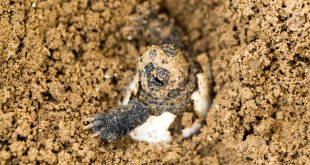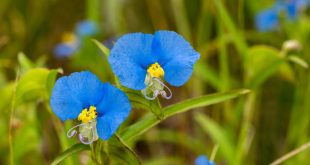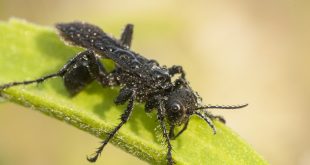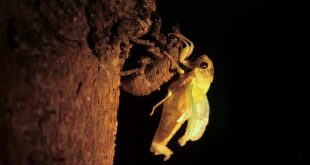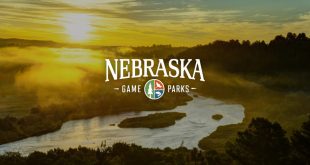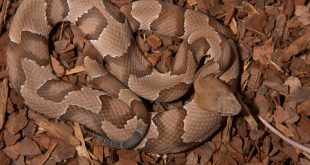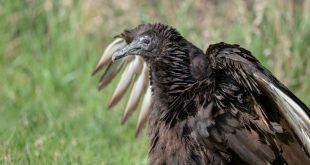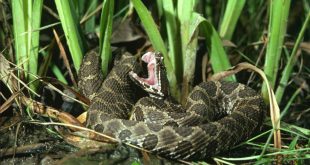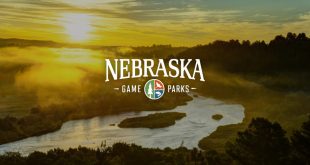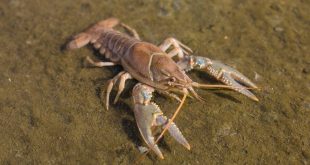By Monica Macoubrie, Wildlife Education Specialist This is a familiar sight in Nebraska: You’re driving along a two-lane highway listening to the radio, when all of a sudden, a dinosaur walks across the road just ahead of you. OK, not literally a dinosaur, but a living creature that is as close as you can get — a snapping turtle. As you approach the turtle, you notice that it’s earnestly on a mission, however slow and lumbering. It’s trying to make …
Read More »Deceptive Dayflowers
Story and photos by Gerry Steinauer, Botanist As their name implies, each dayflower blossom is fleeting. New flowers that open to greet the rising sun close about noon and wither by dusk. The lovely blue flowers are as delicate as they are short-lived. When rubbed between one’s fingers, their petals quickly disintegrate into a watery ooze. Belonging to the spiderwort family (Commelinaceae), two dayflower species, both growing up to a foot tall, inhabit Nebraska. Slender dayflower (Commelina erecta) is a …
Read More »Why You Should Love Wasps!
Story and Photos by Chris Helzer Wasps are amazing. No, seriously, they’re startlingly cool. To begin with, there are more than 100,000 wasp species that have been cataloged by science and many more that haven’t. Among all those species, there is incredible variation in size, shape, lifestyle and aggression toward humans. Spoiler alert: Only a tiny percentage of wasps pose any threat to us at all. Categorizing all wasps as aggressive, winged canisters of pain is like categorizing all Husker …
Read More »Cicada Sounds
By Jamie Bachmann, Outdoor Educator While there may be plenty of hot days left this summer, I know that cool, fall days are on their way when I begin to hear the distinctive sounds of cicadas. Cicadas are one of the coolest and most noticeable group of insects active during this time of year. Take a look at image above, which shows an exuviae, the remaining exoskeleton of an adult cicada that has just emerged, or eclosed. I’m sure you …
Read More »Catch these Game and Parks education events in August
Nebraska Game and Parks Commission educators have scheduled interesting and engaging events for the curious in August. Here are some opportunities: Nature Nerd Night to feature Ecological Superheroes on Aug. 16 Keystone species are animals that play a major role in their environment’s web of life. Often their existence helps support dozens of other species. Nebraska examples include prairie dogs, bison and beavers. Join the virtual webinar Ecological Superheroes on Aug. 16 and learn more about how keystone species help …
Read More »Nebraska’s Venomous Snakes
By Monica Macoubrie, Wildlife Education Specialist In Nebraska, we have 29 species of snakes, and of those species, only four of them are venomous. They are the prairie rattlesnake (Crotalus viridis), western massasauga rattlesnake (Sistrurus tergeminus), timber rattlesnake (Crotalus horridus) and copperhead (Agkistrodon contortrix). Generally found in the western half of Nebraska, the prairie rattlesnake has the widest range of all, while the other three species are restricted to the southeast. All four are considered pit vipers. Vipers are a …
Read More »Nebraska’s Third Black Vulture
By Joel Jorgensen Spring is a period when many birds are on the move. This means it is a great time of year for birders to be on the lookout for rarities or vagrants. A rarity is a bird that usually appears somewhere outside of its normal range. Finding a rarity sometimes requires special effort, but other times, it’s just luck. On April 26, birder and photographer Steve Kruse discovered a vulture on the ground at Merganser Recreation Area in …
Read More »What Is Snake Venom?
By Monica Macoubrie, Wildlife Education Specialist As an outdoor educator, I hear a lot of discussion about the “poisonous” snakes in Nebraska. Actually, the correct term is venomous snakes, not poisonous. Although both poison and venom can cause death or serious impairment to the function of organs and/or living tissues, these two terms cannot be used interchangeably: Poisons are toxins that are ingested or inhaled, such as a plant or substance; whereas venom is a toxin that is injected, most …
Read More »Catch these Game and Parks education events in July
Nebraska Game and Parks Commission educators have scheduled interesting and engaging events for the curious in July. Here are some opportunities: Nature Nerd Night to feature Aquatic Wonders on July 19 Fish, with their scales, swim bladders and lateral lines, have amazing adaptations. In the Nebraska Nature Nerd Night virtual webinar Aquatic Wonders, outdoor educators will discuss the diversity and life strategies of Nebraska fish. The free event starts at 7 p.m. Central time July 19. Registration is required through …
Read More »Nebraska’s Crayfish
By Grace Gaard, Outdoor Educator Crayfish – also known as crawdad, crawfish and mudbug – is no fish. It’s an arthropod and more specifically, a freshwater crustacean. With their jointed legs and protective exoskeleton, crayfish are a unique part of Nebraska’s aquatic ecosystems. A crayfish’s body is comprised of three main parts: head, thorax and abdomen – similar to their distant insect relatives. Where crayfish begin to differ from insects, however, is that they have five pairs of legs, giving …
Read More » Nebraskaland Magazine
Nebraskaland Magazine
